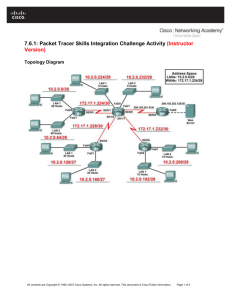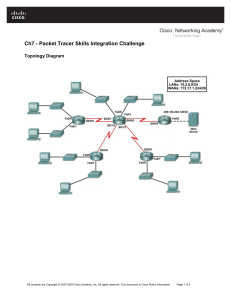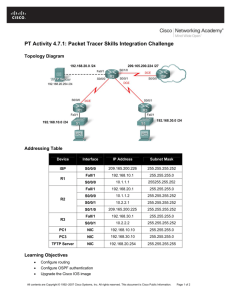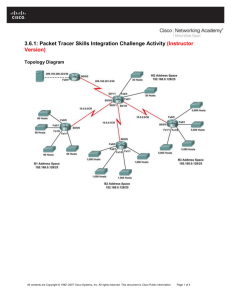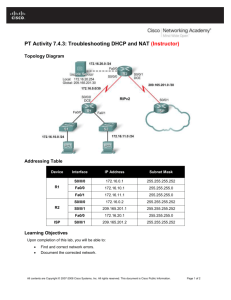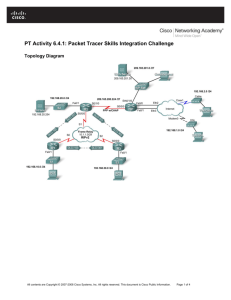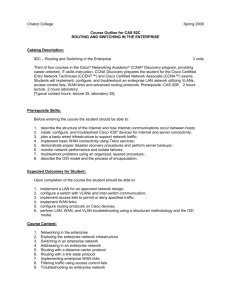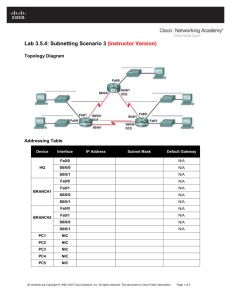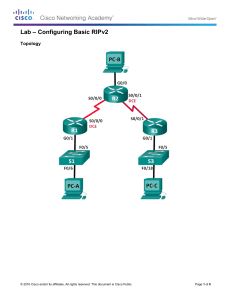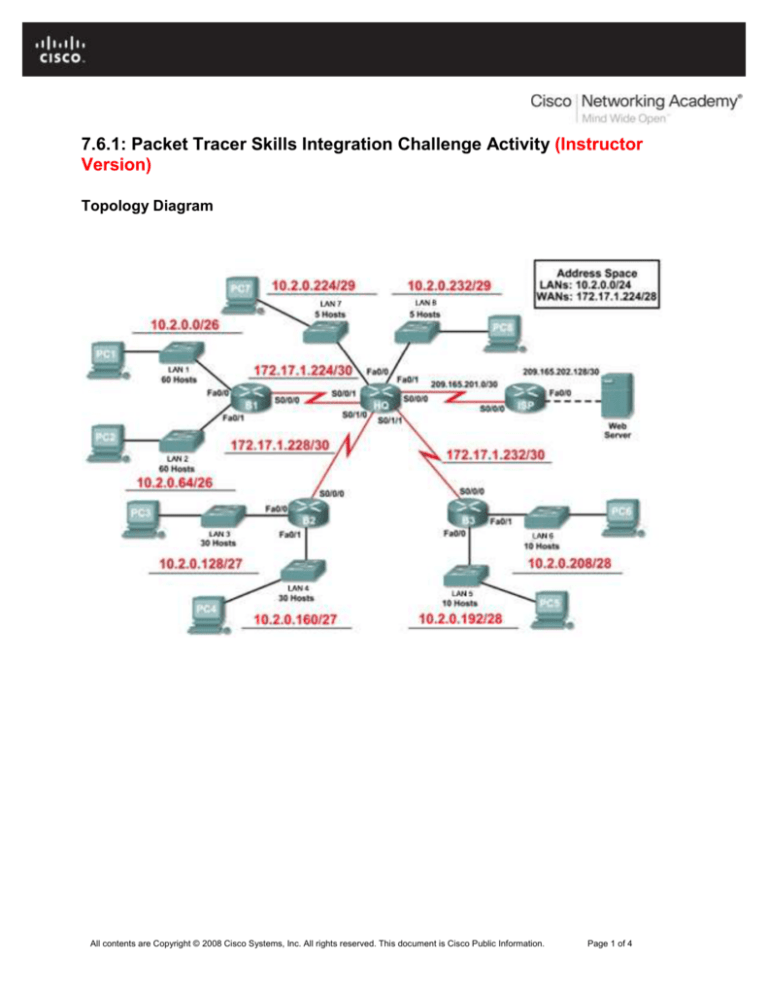
7.6.1: Packet Tracer Skills Integration Challenge Activity (Instructor
Version)
Topology Diagram
All contents are Copyright © 2008 Cisco Systems, Inc. All rights reserved. This document is Cisco Public Information.
Page 1 of 4
CCNA Exploration
Routing Protocols and Concepts: RIPv2
7.6.1: Packet Tracer Skills Integration Challenge Activity
Addressing Table
Device
Interface
IP Address
Subnet Mask
Default Gateway
Fa0/0
10.2.0.225
255.255.255.248
N/A
Fa0/1
10.2.0.233
255.255.255.248
N/A
S0/0/0
209.165.201.2
255.255.255.252
N/A
S0/0/1
172.17.1.225
255.255.255.252
N/A
S0/1/0
172.17.1.229
255.255.255.252
N/A
S0/1/1
172.17.1.233
255.255.255.252
N/A
Fa0/0
10.2.0.1
255.255.255.192
N/A
Fa0/1
10.2.0.65
255.255.255.192
N/A
S0/0/0
172.17.1.226
255.255.255.252
N/A
Fa0/0
10.2.0.129
255.255.255.224
N/A
Fa0/1
10.2.0.161
255.255.255.224
N/A
S0/0/0
172.17.1.230
255.255.255.252
N/A
Fa0/0
10.2.0.193
255.255.255.240
N/A
Fa0/1
10.2.0.209
255.255.255.240
N/A
S0/0/0
172.17.1.234
255.255.255.252
N/A
Fa0/0
209.165.202.129
255.255.255.252
N/A
S0/0/0
209.165.201.1
255.255.255.252
N/A
Web
Server
NIC
209.165.202.130
255.255.255.252
209.165.202.129
PC1
NIC
10.2.0.62
255.255.255.192
10.2.0.1
PC2
NIC
10.2.0.126
255.255.255.192
10.2.0.65
PC3
NIC
10.2.0.158
255.255.255.224
10.2.0.129
PC4
NIC
10.2.0.190
255.255.255.224
10.2.0.161
PC5
NIC
10.2.0.206
255.255.255.240
10.2.0.193
PC6
NIC
10.2.0.222
255.255.255.240
10.2.0.209
PC7
NIC
10.2.0.230
255.255.255.248
10.2.0.225
PC8
NIC
10.2.0.238
255.255.255.248
10.2.0.233
HQ
B1
B2
B3
ISP
All contents are Copyright © 2008 Cisco Systems, Inc. All rights reserved. This document is Cisco Public Information.
Page 2 of 4
CCNA Exploration
Routing Protocols and Concepts: RIPv2
7.6.1: Packet Tracer Skills Integration Challenge Activity
Introduction:
This Packet Tracer Skills Integration Challenge Activity is very similar to the activities you have created in
prior chapters. To allow you to better practice your skills, the scenario is slightly different. In this activity,
you build a network from the ground up. Starting with a given address space and network requirements,
you must implement a network design that satisfies the specifications. Next, you implement an effective
RIPv2 routing configuration with static and default routing for Internet access.
Objectives
Design and document an addressing scheme based on requirements.
Select appropriate equipment and cable the devices.
Apply a basic configuration to the devices.
Test connectivity between directly connected devices.
Configure RIPv2 routing.
Configure static and default routing for Internet access.
Verify full connectivity between all devices in the topology.
Task 1: Design and document an addressing scheme.
Step 1: Design an addressing scheme.
Based on the network requirements shown in the topology, design an appropriate addressing scheme.
Address the LANs in order starting with LAN 1, then LAN 2, etc. Use the first address for the
router interface and the last address for the PC.
Address the WANs in order starting with WAN 1, then WAN 2, etc. HQ is the first usable address
in all WAN links, with the exception of the link to ISP. For the ISP link, HQ uses the second
usable address.
Step 2: Document the addressing scheme.
Record the network addresses in dotted-decimal/slash format
Document the IP addresses, subnet masks and default gateway addresses.
Task 2: Apply a basic configuration.
Step 1: Configure the routers.
Using your documentation, configure the routers with basic configurations, including addressing and
hostnames. Use cisco as the line passwords (console and Telnet). Use class as the enable secret
password.
Step 2: Configure the PCs.
Using your documentation, configure the PCs with an IP address, subnet mask, and default gateway.
Task 3: Test connectivity.
Before continuing, make sure that each device can ping its directly connected neighbor.
All contents are Copyright © 2008 Cisco Systems, Inc. All rights reserved. This document is Cisco Public Information.
Page 3 of 4
CCNA Exploration
Routing Protocols and Concepts: RIPv2
7.6.1: Packet Tracer Skills Integration Challenge Activity
Task 4: Configure and verify RIPv2 routing.
Step 1: Configure RIPv2.
Configure all devices with RIPv2 routing. In your configuration, make sure you include the following:
Disable automatic summarization.
Stop routing updates on interfaces that are not connected to RIP neighbors.
Set a default route from HQ to ISP using the next-hop IP address.
Configure static routes on the ISP using the outbound interface.
Redistribute default route from HQ.
Step 2: Verify RIPv2.
Use verification commands to check your configuration. All routers should be converged on all the
10.2.0.0/24 and 172.17.1.224/28 subnets
Task 5: Test connectivity and examine the configuration.
Test connectivity and examine the configuration.
All contents are Copyright © 2008 Cisco Systems, Inc. All rights reserved. This document is Cisco Public Information.
Page 4 of 4

